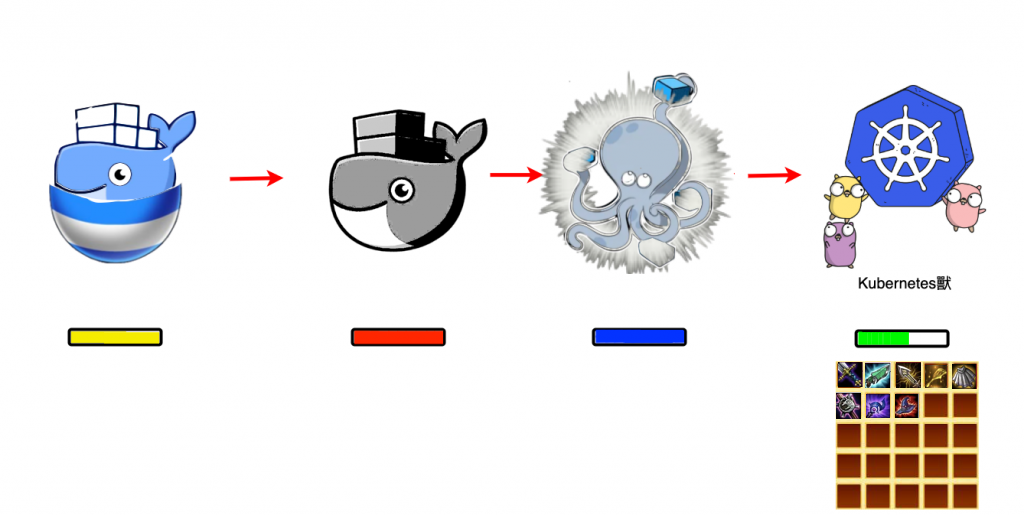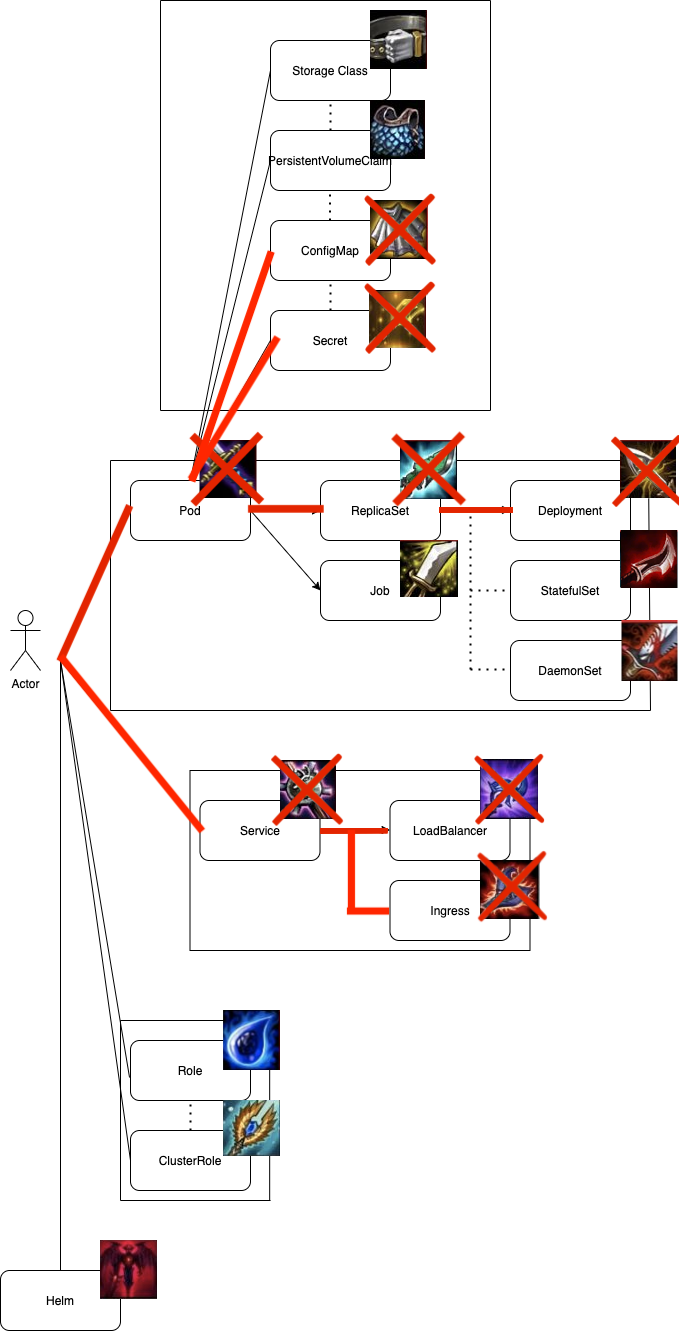在分享完Pod, ReplicaSet與Deployment三祖孫的故事並學會如何使用後,接下來要分享給大家如何依照策略的將pod部署在特定節點上,讓我們可以因應不同的情境選擇不一樣的佈署策略。
如同字面上意思,Affinity 與 Anti-Affinity指的是親和性調度與反親和性調度,也就是滿足特定條件後,(不)將Pod調度到特定群集上。
節點調度與驅逐策略當中,最簡單的方式。藉由給定Node指定的標籤,讓Pod可以只在特定節點上運行。
首先,我們一樣準備一個三節點的乾淨Cluster。(也就是先前練習用的Cluster,並清空之前練習留下的resources)
$ kubectl get pod
No resources found in default namespace.
$ kubectl get node
NAME STATUS ROLES AGE VERSION
gke-my-first-cluster-1-default-pool-dddd2fae-j0k1 Ready <none> 11d v1.18.6-gke.3504
gke-my-first-cluster-1-default-pool-dddd2fae-rfl8 Ready <none> 11d v1.18.6-gke.3504
gke-my-first-cluster-1-default-pool-dddd2fae-tz38 Ready <none> 11d v1.18.6-gke.3504
在某一Node上加上特定標籤env:stg
kubectl label nodes <node_name> =
$ kubectl label nodes gke-my-first-cluster-1-default-pool-dddd2fae-tz38 env=stg
node/gke-my-first-cluster-1-default-pool-dddd2fae-tz38 labeled
將nodeSelector 加到pod(deployment)中
這邊我們以repository的deployment為例
apiVersion: apps/v1
kind: Deployment
metadata:
name: ironman
labels:
name: ironman
app: ironman
spec:
minReadySeconds: 5
strategy:
type: RollingUpdate
rollingUpdate:
maxSurge: 1
maxUnavailable: 1
selector:
matchLabels:
app: ironman
replicas: 1
template:
metadata:
labels:
app: ironman
spec:
nodeSelector:
env: stg
containers:
- name: ironman
image: ghjjhg567/ironman:latest
imagePullPolicy: Always
ports:
- containerPort: 8100
resources:
limits:
cpu: "1"
memory: "2Gi"
requests:
cpu: 500m
memory: 256Mi
envFrom:
- secretRef:
name: ironman-config
command: ["./docker-entrypoint.sh"]
- name: redis
image: redis:4.0
imagePullPolicy: Always
ports:
- containerPort: 6379
- name: nginx
image: nginx
imagePullPolicy: Always
ports:
- containerPort: 80
volumeMounts:
- mountPath: /etc/nginx/nginx.conf
name: nginx-conf-volume
subPath: nginx.conf
readOnly: true
- mountPath: /etc/nginx/conf.d/default.conf
subPath: default.conf
name: nginx-route-volume
readOnly: true
readinessProbe:
httpGet:
path: /v1/hc
port: 80
initialDelaySeconds: 5
periodSeconds: 10
volumes:
- name: nginx-conf-volume
configMap:
name: nginx-config
- name: nginx-route-volume
configMap:
name: nginx-route-volume
再來我們將加上nodeSelector的deployment部署到cluster上
$ kubectl get pod --watch
NAME READY STATUS RESTARTS AGE
ironman-7c7d8dd78-b2zp5 3/3 Running 0 24s
我們最後來分析一下加上nodeSelector的pod吧!!
在下方能看見我們的三個replicas都只運行在加上label的節點,這也證實nodeSelector確實能work
$ kubectl get pod
NAME READY STATUS RESTARTS AGE
ironman-7c7d8dd78-b2zp5 0/3 ContainerCreating 0 5s
$ kubectl describe pod ironman-7c7d8dd78-b2zp5
Name: ironman-7c7d8dd78-b2zp5
Namespace: default
Priority: 0
Node: gke-my-first-cluster-1-default-pool-dddd2fae-tz38/10.140.0.3
Start Time: Mon, 05 Oct 2020 17:50:32 +0800
Labels: app=ironman
接下來就是NodeAffinity,它算是進階版的NodeSelector,NodeAffinity除了上述Selector功能外,NodeAffinity還有著兩種不同的策略,分別是requiredDuringSchedulingIgnoredDuringExecution 和 preferredDuringSchedulingIgnoredDuringExecution,也就是硬親和與軟親和。
我們將上面yaml中的nodeSelector —> nodeAffinity
apiVersion: apps/v1
kind: Deployment
metadata:
name: ironman
labels:
name: ironman
app: ironman
spec:
minReadySeconds: 5
strategy:
type: RollingUpdate
rollingUpdate:
maxSurge: 1
maxUnavailable: 1
selector:
matchLabels:
app: ironman
replicas: 1
template:
metadata:
labels:
app: ironman
spec:
affinity:
nodeAffinity:
requiredDuringSchedulingIgnoredDuringExecution:
nodeSelectorTerms:
- matchExpressions:
- key: env
operator: In
values:
- test
- uat
containers:
- name: ironman
image: ghjjhg567/ironman:latest
imagePullPolicy: Always
ports:
- containerPort: 8100
resources:
limits:
cpu: "1"
memory: "2Gi"
requests:
cpu: 500m
memory: 256Mi
envFrom:
- secretRef:
name: ironman-config
command: ["./docker-entrypoint.sh"]
- name: redis
image: redis:4.0
imagePullPolicy: Always
ports:
- containerPort: 6379
- name: nginx
image: nginx
imagePullPolicy: Always
ports:
- containerPort: 80
volumeMounts:
- mountPath: /etc/nginx/nginx.conf
name: nginx-conf-volume
subPath: nginx.conf
readOnly: true
- mountPath: /etc/nginx/conf.d/default.conf
subPath: default.conf
name: nginx-route-volume
readOnly: true
readinessProbe:
httpGet:
path: /v1/hc
port: 80
initialDelaySeconds: 5
periodSeconds: 10
volumes:
- name: nginx-conf-volume
configMap:
name: nginx-config
- name: nginx-route-volume
configMap:
name: nginx-route-volume
這邊可以發現,我們的剛加上硬親和性的Pod是起不來的,因為我們在上面給的label為env: stg,但是硬親和性的規則是要env:test 或env:uat
$ kubectl apply -f deployment.yaml
NAME READY UP-TO-DATE AVAILABLE AGE
ironman 0/1 1 0 17s
kubectl get pod --watch
NAME READY STATUS RESTARTS AGE
ironman-6d655d444d-gffx6 2/3 Terminating 0 9m32s
ironman-db66975d8-rtvgg 0/3 Pending 0 21s
ironman-6d655d444d-gffx6 0/3 Terminating 0 9m36s
ironman-6d655d444d-gffx6 0/3 Terminating 0 9m48s
ironman-6d655d444d-gffx6 0/3 Terminating 0 9m48s
ironman-db66975d8-rtvgg 0/3 Pending 0 37s
那我們再來將硬親和性的operator value加上stg,並且再加上軟親和性。
Tips: 這邊的weight很重要!
apiVersion: apps/v1
kind: Deployment
metadata:
name: ironman
labels:
name: ironman
app: ironman
spec:
minReadySeconds: 5
strategy:
type: RollingUpdate
rollingUpdate:
maxSurge: 1
maxUnavailable: 1
selector:
matchLabels:
app: ironman
replicas: 1
template:
metadata:
labels:
app: ironman
spec:
affinity:
nodeAffinity:
requiredDuringSchedulingIgnoredDuringExecution:
nodeSelectorTerms:
- matchExpressions:
- key: env
operator: In
values:
- test
- stg
preferredDuringSchedulingIgnoredDuringExecution:
- weight: 1
preference:
matchExpressions:
- key: priority
operator: In
values:
- first
containers:
- name: ironman
image: ghjjhg567/ironman:latest
imagePullPolicy: Always
ports:
- containerPort: 8100
resources:
limits:
cpu: "1"
memory: "2Gi"
requests:
cpu: 500m
memory: 256Mi
envFrom:
- secretRef:
name: ironman-config
command: ["./docker-entrypoint.sh"]
- name: redis
image: redis:4.0
imagePullPolicy: Always
ports:
- containerPort: 6379
- name: nginx
image: nginx
imagePullPolicy: Always
ports:
- containerPort: 80
volumeMounts:
- mountPath: /etc/nginx/nginx.conf
name: nginx-conf-volume
subPath: nginx.conf
readOnly: true
- mountPath: /etc/nginx/conf.d/default.conf
subPath: default.conf
name: nginx-route-volume
readOnly: true
readinessProbe:
httpGet:
path: /v1/hc
port: 80
initialDelaySeconds: 5
periodSeconds: 10
volumes:
- name: nginx-conf-volume
configMap:
name: nginx-config
- name: nginx-route-volume
configMap:
name: nginx-route-volume
執行後可以發現,我們已經滿足硬親和性,並且即使尚未滿足軟親和性還是會create pod。
$ kubectl apply -f deployment.yaml
deployment.apps/ironman created
$ kubectl get pod --watch
NAME READY STATUS RESTARTS AGE
ironman-5bb87585db-pqp8b 0/3 ContainerCreating 0 3s
ironman-5bb87585db-pqp8b 2/3 Running 0 8s
ironman-5bb87585db-pqp8b 2/3 Running 0 14s
ironman-5bb87585db-pqp8b 3/3 Running 0 18s
ironman-5bb87585db-pqp8b 3/3 Running 0 18s
那假使有另個Node是同時滿足硬親和同時滿足硬親和與軟親和的話,他的優先序會在只滿足硬親和的Node之前嗎?
$ kubectl label nodes gke-my-first-cluster-1-default-pool-dddd2fae-rfl8 env=stg
node/gke-my-first-cluster-1-default-pool-dddd2fae-rfl8 labeled
$ kubectl label nodes gke-my-first-cluster-1-default-pool-dddd2fae-rfl8 priority=first
node/gke-my-first-cluster-1-default-pool-dddd2fae-rfl8 labeled
$ kubectl apply -f deployment.yaml
deployment.apps/ironman created
那我們來看看結果吧!結論就是在都滿足硬親和的條件下,Kubernetes scheduler會依照加上的weight分數來決定部署在哪個node上。
$ kubectl get pod
NAME READY STATUS RESTARTS AGE
ironman-9c45876f7-ztskh 3/3 Running 0 39s
$ kubectl describe pod ironman-9c45876f7-ztskh
Name: ironman-9c45876f7-ztskh
Namespace: default
Priority: 0
Node: gke-my-first-cluster-1-default-pool-dddd2fae-rfl8/10.140.0.2
Start Time: Mon, 05 Oct 2020 18:16:40 +0800
Labels: app=ironman
pod-template-hash=9c45876f7
Annotations: <none>
Status: Running
IP: 10.0.0.25
IPs:
與NodeAffinity相似,但層級變成了Pod,並且Pod還有著PodAntiAffinity反親和性。
在下面兩個不同node中,我們可以拿兩者都有的labels來做範例
$ kubectl get node gke-my-first-cluster-1-default-pool-dddd2fae-j0k1 --show-labels
NAME STATUS ROLES AGE VERSION LABELS
gke-my-first-cluster-1-default-pool-dddd2fae-j0k1 Ready <none> 11d v1.18.6-gke.3504 beta.kubernetes.io/arch=amd64,beta.kubernetes.io/instance-type=g1-small,beta.kubernetes.io/os=linux,cloud.google.com/gke-nodepool=default-pool,cloud.google.com/gke-os-distribution=cos,cloud.google.com/machine-family=g1,failure-domain.beta.kubernetes.io/region=asia-east1,failure-domain.beta.kubernetes.io/zone=asia-east1-a,kubernetes.io/arch=amd64,kubernetes.io/hostname=gke-my-first-cluster-1-default-pool-dddd2fae-j0k1,kubernetes.io/os=linux,node.kubernetes.io/instance-type=g1-small,topology.kubernetes.io/region=asia-east1,topology.kubernetes.io/zone=asia-east1-a
$ kubectl get nodes gke-my-first-cluster-1-default-pool-dddd2fae-rfl8 --show-labels
NAME STATUS ROLES AGE VERSION LABELS
gke-my-first-cluster-1-default-pool-dddd2fae-rfl8 Ready <none> 11d v1.18.6-gke.3504 beta.kubernetes.io/arch=amd64,beta.kubernetes.io/instance-type=g1-small,beta.kubernetes.io/os=linux,cloud.google.com/gke-nodepool=default-pool,cloud.google.com/gke-os-distribution=cos,cloud.google.com/machine-family=g1,env=stg,failure-domain.beta.kubernetes.io/region=asia-east1,failure-domain.beta.kubernetes.io/zone=asia-east1-a,kubernetes.io/arch=amd64,kubernetes.io/hostname=gke-my-first-cluster-1-default-pool-dddd2fae-rfl8,kubernetes.io/os=linux,node.kubernetes.io/instance-type=g1-small,priority=first,topology.kubernetes.io/region=asia-east1,topology.kubernetes.io/zone=asia-east1-a
在這兩個node中,我們發現他們都有著label "kubernetes.io/hostname" 並且兩者的值分別為gke-my-first-cluster-1-default-pool-dddd2fae-j0k1與nodes gke-my-first-cluster-1-default-pool-dddd2fae-rfl8。假設有a, b, c三個pod,若a, c在kubernetes.io/hostname: gke-my-first-cluster-1-default-pool-dddd2fae-j0k1,b在kubernetes.io/hostname: gke-my-first-cluster-1-default-pool-dddd2fae-rfl8上,則稱b與ac不同topology。
老樣子先來個yaml,這邊可以發現我們有個ironman-1的deployment,且他想親和有著標籤ironman:one或ironman:three的pod,並且想遠離ironman:two的pod。那接著我們再來兩個yaml分別為ironman-2與ironman-3 做測試。
ironman-1.yaml
apiVersion: apps/v1
kind: Deployment
metadata:
name: ironman-1
labels:
name: ironman
app: ironman
spec:
minReadySeconds: 5
strategy:
type: RollingUpdate
rollingUpdate:
maxSurge: 1
maxUnavailable: 1
selector:
matchLabels:
app: ironman
replicas: 1
template:
metadata:
labels:
app: ironman
ironman: one
spec:
affinity:
podAffinity:
requiredDuringSchedulingIgnoredDuringExecution:
- labelSelector:
matchExpressions:
- key: ironman
operator: In
values:
- one
- three
topologyKey: kubernetes.io/hostname
podAntiAffinity:
preferredDuringSchedulingIgnoredDuringExecution:
- weight: 100
podAffinityTerm:
labelSelector:
matchExpressions:
- key: ironman
operator: In
values:
- two
topologyKey: kubernetes.io/hostname
containers:
- name: ironman
image: ghjjhg567/ironman:latest
imagePullPolicy: Always
ports:
- containerPort: 8100
envFrom:
- secretRef:
name: ironman-config
command: ["./docker-entrypoint.sh"]
- name: redis
image: redis:4.0
imagePullPolicy: Always
ports:
- containerPort: 6379
- name: nginx
image: nginx
imagePullPolicy: Always
ports:
- containerPort: 80
volumeMounts:
- mountPath: /etc/nginx/nginx.conf
name: nginx-conf-volume
subPath: nginx.conf
readOnly: true
- mountPath: /etc/nginx/conf.d/default.conf
subPath: default.conf
name: nginx-route-volume
readOnly: true
readinessProbe:
httpGet:
path: /v1/hc
port: 80
initialDelaySeconds: 5
periodSeconds: 10
volumes:
- name: nginx-conf-volume
configMap:
name: nginx-config
- name: nginx-route-volume
configMap:
name: nginx-route-volume
ironman-2.yaml
apiVersion: apps/v1
kind: Deployment
metadata:
name: ironman-2
labels:
name: ironman
app: ironman
spec:
minReadySeconds: 5
strategy:
type: RollingUpdate
rollingUpdate:
maxSurge: 1
maxUnavailable: 1
selector:
matchLabels:
app: ironman
replicas: 1
template:
metadata:
labels:
app: ironman
ironman: two
spec:
affinity:
podAffinity:
requiredDuringSchedulingIgnoredDuringExecution:
- labelSelector:
matchExpressions:
- key: ironman
operator: In
values:
- two
topologyKey: kubernetes.io/hostname
podAntiAffinity:
preferredDuringSchedulingIgnoredDuringExecution:
- weight: 100
podAffinityTerm:
labelSelector:
matchExpressions:
- key: ironman
operator: In
values:
- one
- three
topologyKey: kubernetes.io/hostname
containers:
- name: ironman
image: ghjjhg567/ironman:latest
imagePullPolicy: Always
ports:
- containerPort: 8100
envFrom:
- secretRef:
name: ironman-config
command: ["./docker-entrypoint.sh"]
- name: redis
image: redis:4.0
imagePullPolicy: Always
ports:
- containerPort: 6379
- name: nginx
image: nginx
imagePullPolicy: Always
ports:
- containerPort: 80
volumeMounts:
- mountPath: /etc/nginx/nginx.conf
name: nginx-conf-volume
subPath: nginx.conf
readOnly: true
- mountPath: /etc/nginx/conf.d/default.conf
subPath: default.conf
name: nginx-route-volume
readOnly: true
readinessProbe:
httpGet:
path: /v1/hc
port: 80
initialDelaySeconds: 5
periodSeconds: 10
volumes:
- name: nginx-conf-volume
configMap:
name: nginx-config
- name: nginx-route-volume
configMap:
name: nginx-route-volume
ironman-3.yaml
apiVersion: apps/v1
kind: Deployment
metadata:
name: ironman-3
labels:
name: ironman
app: ironman
spec:
minReadySeconds: 5
strategy:
type: RollingUpdate
rollingUpdate:
maxSurge: 1
maxUnavailable: 1
selector:
matchLabels:
app: ironman
replicas: 1
template:
metadata:
labels:
app: ironman
ironman: three
spec:
affinity:
podAffinity:
requiredDuringSchedulingIgnoredDuringExecution:
- labelSelector:
matchExpressions:
- key: ironman
operator: In
values:
- one
- three
topologyKey: kubernetes.io/hostname
podAntiAffinity:
preferredDuringSchedulingIgnoredDuringExecution:
- weight: 100
podAffinityTerm:
labelSelector:
matchExpressions:
- key: ironman
operator: In
values:
- two
topologyKey: kubernetes.io/hostname
containers:
- name: ironman
image: ghjjhg567/ironman:latest
imagePullPolicy: Always
ports:
- containerPort: 8100
envFrom:
- secretRef:
name: ironman-config
command: ["./docker-entrypoint.sh"]
- name: redis
image: redis:4.0
imagePullPolicy: Always
ports:
- containerPort: 6379
- name: nginx
image: nginx
imagePullPolicy: Always
ports:
- containerPort: 80
volumeMounts:
- mountPath: /etc/nginx/nginx.conf
name: nginx-conf-volume
subPath: nginx.conf
readOnly: true
- mountPath: /etc/nginx/conf.d/default.conf
subPath: default.conf
name: nginx-route-volume
readOnly: true
readinessProbe:
httpGet:
path: /v1/hc
port: 80
initialDelaySeconds: 5
periodSeconds: 10
volumes:
- name: nginx-conf-volume
configMap:
name: nginx-config
- name: nginx-route-volume
configMap:
name: nginx-route-volume
並且分別佈署它們
$ kubectl apply -f ironman-1.yaml
deployment.apps/ironman-1 created
$ kubectl apply -f ironman-2.yaml
deployment.apps/ironman-2 created
$ kubectl apply -f ironman-3.yaml
deployment.apps/ironman-3 created
這時我們理想狀態應該是1與3在同個node上,並且2獨自在另個node上,那我們來驗證一下吧~
$ kubectl get pod
NAME READY STATUS RESTARTS AGE
ironman-1-59cc5784ff-l9lh6 3/3 Running 0 41s
ironman-2-67647c9b7c-5n6f4 3/3 Running 0 34s
ironman-3-5797656cf5-662td 3/3 Running 0 29s
$ kubectl describe pod ironman-1-59cc5784ff-l9lh6
Name: ironman-1-59cc5784ff-l9lh6
Namespace: default
Priority: 0
Node: gke-my-first-cluster-1-default-pool-dddd2fae-j0k1/10.140.0.4
Start Time: Mon, 05 Oct 2020 19:20:14 +0800
kubectl describe pod ironman-2-67647c9b7c-5n6f4
Name: ironman-2-67647c9b7c-5n6f4
Namespace: default
Priority: 0
Node: gke-my-first-cluster-1-default-pool-dddd2fae-tz38/10.140.0.3
$ kubectl describe pod ironman-3-5797656cf5-662td
Name: ironman-3-5797656cf5-662td
Namespace: default
Priority: 0
Node: gke-my-first-cluster-1-default-pool-dddd2fae-j0k1/10.140.0.4
那最後結果也似乎與我們預期相同,這也驗證了親和性與反親和性的功能確實可以運作。
但一定會有機率是無法同時滿足podAffinity與podAntiAffinity的情況,這時候就是weight出現的時候了,同樣會算出滿足親和性條件下,反親和分數最高的topology去部署
原本想在這章節一起介紹Taints and Tolerations,但後來介紹Affinity親和性時,發現篇幅有點過長,因此將Taints污點放在下個章節單獨介紹Orz,有興趣的朋友麻煩再參閱Day-24囉。

